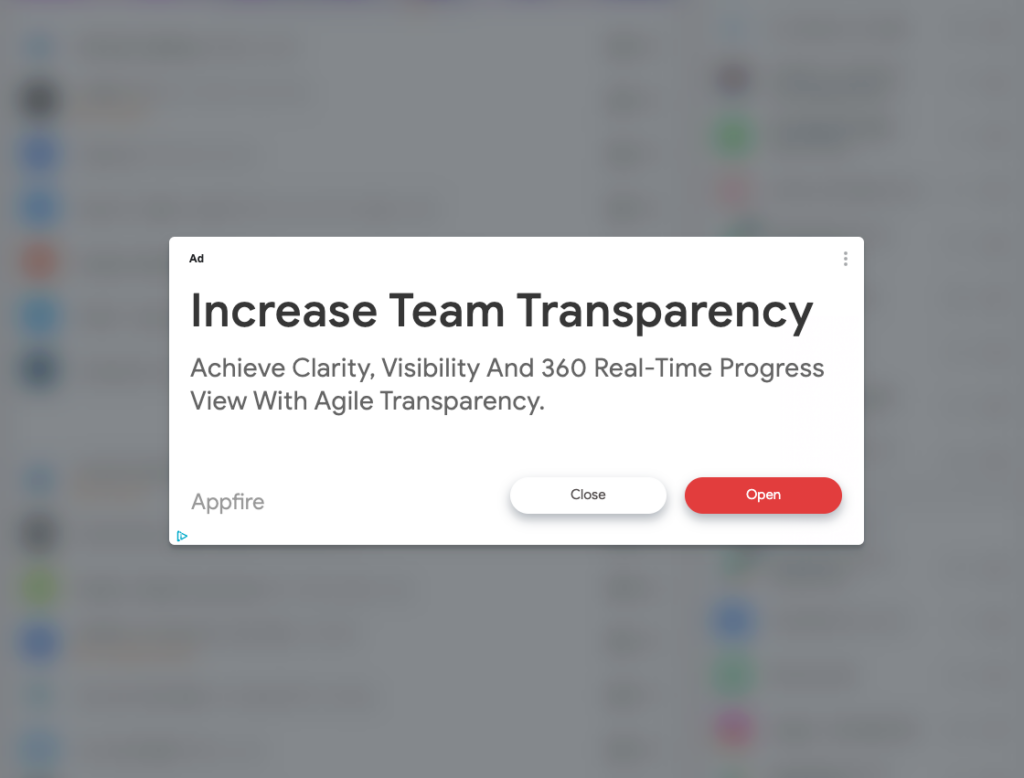
Display advertising
Summary
Learn everything you need to know about display advertising, including:
- Why it’s important to brands
- The different types of display ads
- How to target the right audiences
- What you need to measure success
What is display advertising?
Display advertising is any form of digital ad that includes both copy and visual elements, such as images, videos or gifs. They’re found across the web, typically appearing at the top or sides of content where they stand the best chance of getting noticed by users.
Along with paid search, display ads are among the most common forms of pay-per-click advertising, where users are charged based on the number of clicks their ads get rather than the number of impressions. This type of marketing has proven highly effective and is only set to grow in the coming years, making it an important format to consider for any campaign. For instance, take a look at these stats:
- 22 per cent of marketers use display ads as part of their marketing strategy.
- Display ad spending is set to reach $352.2 billion (£275.9 billion) by the end of 2024.
- Retailers are the biggest users of display ads, accounting for 24.7 per cent of US spending.
- More than 90 per cent of display ad investment goes towards programmatic ad buys.
What are some common types of display ads?
Display ads come in a variety of formats, so it’s important when designing an ad that you understand what options are available and which would be best-suited to your brand, budget and campaign objectives. Here are some of the most common types of display ads that you should be considering.
Banner ads

Among the most common types of display ad, this content appears across the top, bottom or sides of a web page. They’re usually among the first elements a user sees when they arrive on a site and so are great for driving traffic and boosting awareness.
Interstitial ads

These ads come in the form of full-screen promotions that take up the entire screen of a website or app. More commonly seen on mobiles, where users tend to be more accepting of them, they can appear while moving between screens or waiting for other content to load and their nature makes them hard to ignore.
Rich media ads
These often come in the form of video ads, but can have other interactive elements such as design that responds to a user’s inputs. They may expand when hovered over, for instance, or play video on a click. This helps them deliver engaging content without disturbing the user.
Native ads

Native ads are designed to look and feel similar to the content around them and so appear less intrusive to users. Often tagged with ‘sponsored’ or ‘promoted’ on social media, they can include images, videos, or interactive elements. They’re less obvious than other types of ads and are sometimes considered their own category, but the purpose remains the same – to engage and convert users.
In addition to the different types of ads, there are also a number of options for how you place your content to target potential customers. Some of the most common are:
Remarketing ads
Also known as retargeting ads, this type of display ad allows you to target users who have already shown an interest in your brand. This offers improved conversion rates by focusing your attention on the most promising customers.
Contextual ads
This type of ad works by placing your content on websites that are relevant to your brand or the product or service you’re advertising. For example, a retailer selling running shoes may opt to focus its display ads on websites talking about health and fitness. There are a number of criteria for choosing where your ad appears, including user interests, location and specified keywords.
Site placement advertising
For maximum control over where your digital display advertising appears, website placement allows you to select specific websites to host your ads. This may be entire sites or even individual landing pages where your ads will be positioned. This can be an effective approach if you want to achieve maximum relevance or target customers at a particular point on their purchasing journey.
Why are display ads important?
Display advertising is one of the most effective ways to improve brand awareness, engage with users who’ve already shown interest in your brand or the type of products or services you offer, or encourage individuals to complete a specific action, such as signing up for a free trial.
As such, they are a highly versatile asset that can be used at almost any stage of the marketing funnel. Because they include compelling visual elements and enable companies to incorporate key aspects of their branding, like colours and logos, they can grab the attention of viewers and stick in their minds more strongly than other types of advertising, such as search ads.
Display ads advantages and disadvantages
Some of the main advantages of using display ads in your marketing include:
- Visual appeal – Strong, impactful imagery, video or animation can catch users’ attention and help you stand out from the crowd.
- Reach – Google Display Network alone covers 90 per cent of internet users, while social media sites like Facebook and LinkedIn also enable you to be seen by potentially hundreds of millions of users.
- Targeting – Display ad networks such as Google and Facebook offer a huge range of targeting criteria, enabling you to tailor your ad appearances to as wide or specific an audience as you like.
- Measurement – Similarly, these platforms provide many tools and metrics you can refer to in order to gauge the effectiveness of campaigns.
Of course, there are also some downsides that these advantages must be weighed against. Some key cons to consider include:
- Disruption – The more overt a display ad is, the higher the likelihood that a user will find it intrusive or disruptive. This can be especially true for interstitial or pop-up ads that interrupt a user’s browsing experience,
- Cookies/ad-blocking – Some types of display ad tactics, such as retargeting, rely on users accepting cookies to work, which is no longer as certain as it once was. Use of ad blocking software may also impact their reach to some target audiences.
- Conversion rates – Even the best display ads can expect to see a lower conversion rate than options such as search ads. By their nature, display ads are outbound marketing, making them better for brand awareness than direct sales or lead gen.
- Control – Unless you’re using site placement advertising, you may have little control over where your ads appear or what content they’re seen alongside. This may mean appearing on irrelevant websites or, in worst-case scenarios, in places that could damage your reputation.
Why should you use display advertising?
If you get your campaign strategy right, display advertising can play a crucial and highly productive role in your broader digital marketing efforts. Reasons to use display ads include:
- Grow and maintain your audience – Becoming more familiar with your name will make users more likely to buy from you or take other positive actions in the future. Display advertising also helps you strengthen existing customer relationships by showcasing offers or new products.
- Instant impact – There are also times when it’s beneficial to have a quick and powerful impact on your audience. Display advertising can help you do this with content that is designed to be visually compelling and attention-grabbing, such as a well-designed banner ad.
- Ease of use – Platforms like Google Display Network and Meta make it quick and easy to plan, target and launch a display ad campaign. They also provide the tools you need to measure performance and track how much you’re spending on advertising, so you can ensure you’re getting good value for money.
- Reach customers at different stages – Whether you want to start building relationships with customers who are still researching, or get conversions when users are ready to purchase, display advertising is versatile enough to help you get results.
How much do display ads cost?
The overall cost of a display ad campaign will depend on a number of factors, so there’s no definitive answer to the question of what you can expect to pay. However, on average, using display ads via the Google Display Network is likely to be cheaper than search ads.
Semrush, for instance, notes that in 2024, the average cost-per-click for Google Ads across all industries is $2.69 for search and $0.63 for display.
However, there are lots of variables that go into this, including when and where you want your ads to be shown, the type of sectors you’re targeting and the Quality Score of your ads, to name but a few. If you’re unsure, a dedicated digital advertising agency can help walk you through the options.
Display ad targeting
Targeting is one of the most important aspects of display advertising. You need to ensure your ads are in the right place at the right time to stand any chance of customers not only paying attention to them, but clicking on them.
In the increasingly crowded and competitive digital space, effective targeting is a must if you want to avoid your ads being overshadowed and ignored.
So what methods can you use to improve this aspect of your display ad campaigns?
Affinity audiences
The Google Display Network provides tools to help you reach customers based on their interests, whether they have shown this through active engagement with your products and services, or through their activities and pastimes.
Interest targeting falls into three categories, one of which covers affinity audiences – dozens of separate groups that reflect a range of topics and interests. You can select particular audiences you think would be most interested in your business and choose to show your ads to one or more of them.
Custom affinity audiences
If affinity audiences aren’t specific enough for your needs, you can narrow your scope by using custom affinity audiences, which allow more specific targeting of each display ad campaign you run through specific keywords.
Continuing with the previous example of a retailer selling running shoes, rather than selecting an affinity audience such as ‘sports fans’, this business could target keywords such as ‘long-distance running’, ‘training for a marathon’ or ‘running tips for beginners’.
The company’s ads would then appear on websites containing these keywords, which raises the likelihood of them attracting clicks from engaged, interested customers who are ready to buy.
Facebook also provides a dedicated custom audiences targeting option, which is useful for remarketing because it lets you show ads to people who have recently taken actions such as visiting your website or looking at sales or product pages. Furthermore, you can exclude groups who are unlikely to click on a display advert, such as those who have purchased recently.
In-market audiences
In-market audience targeting is another useful feature of Google’s display ad network that can help you find customers who have shown an interest in products or services similar to yours.
Based on data on past behaviour and activities such as the websites people have visited and the product pages they have looked at, you can set conditions to ensure each Google display ad appears in front of relevant customers.
Facebook Audience Insights
To give yourself the best chance of getting good results on the world’s biggest social media network, make sure you’re using dedicated Facebook advertising tools such as Audience Insights.
This helps you refine your campaign targeting on the platform by collecting information about Facebook users and people already connected to your landing page. You can then take a more informed approach to engaging with customers similar to those already in your audience.
Facebook Audience Insights can help you gather data on:
- Demographic factors such as age, gender, education level and job titles
- People’s interests and hobbies
- Lifestyle indicators such as relationship status and location
Balance targeting and reach
You can take a very precise approach to targeting each display ad campaign you run by layering various criteria. Rather than just targeting people who are interested in running, for example, you could refine your targeting to get your ads in front of running enthusiasts who are female and under the age of 30.
While this can be useful for connecting with niche audiences, you also need to think about your campaign reach: the number of impressions you can expect to achieve within your chosen criteria.
Every time you add a new layer of targeting and get more specific with your audience profile, you reduce the potential reach of your ads. Axonn CTA
How to measure display advertising
To run a successful display advertisement campaign, you need to look ahead and consider how you will measure results and gauge your ROI.
That will involve collecting data on key metrics that will give you insights into how your ads are performing on various fronts.
Impressions
The fundamental starting point for evaluating any display campaign, the impressions metric tells you how many times each ad has been served. This can give you a useful overview of how your campaign is performing in general terms and can also be significant from a bidding and payment perspective – if you choose to pay per 1,000 impressions on the Google ad network, for example.
However, there are drawbacks to impressions as a metric. Firstly, it doesn’t give you a precise idea of how many people have seen a particular display ad, because it may have been shown to the same user multiple times.
Furthermore, a high number of impressions doesn’t necessarily mean lots of people are paying attention to your adverts, since a large proportion of users could simply be scrolling right past them.
Click-through rate
Click-through rate (CTR) is a more specific and informative metric than measurable impressions, because it tells you how many people actually click on each display ad you’re running at any given time. This can help you make data-based judgements about key elements of your advertising, such as the quality and effectiveness of your imagery, copy and CTAs.
CTR also has its shortcomings as a display campaign metric, such as the fact that someone merely clicking through to your website doesn’t tell you much about their level of engagement with your brand or their willingness to buy.
Also, a low CTR doesn’t necessarily mean your ads aren’t working. A customer might see a display ad, remember your name and make their own way to your website at a later date, for example.
Average cost per click
Attracting clicks is a key objective of any display ad campaign, but it’s also important to know how much you’re paying to achieve this goal.
Measuring your average cost per click (CPC) is one of the simplest ways to gauge the financial efficiency of your display advertising. You can calculate average CPC by simply adding up the total cost of all clicks you’ve received and dividing that figure by the overall number of clicks.
Conversions
Measuring your display ad conversion rate is the most effective way to gauge your ROI. At times this is a straightforward process – when you can see that a customer has followed a direct route from clicking on an ad to completing the action you want them to take, for example.
It isn’t always this easy, however. Some people could convert into customers or take the desired action after seeing a display ad but not clicking on it, which might distort your view of how well your ads are performing
There are other metrics that could help you build a more nuanced picture of customer journeys and behaviour, such as view-through. This calculates conversions that occur within 30 days of a user seeing, but not clicking on, a display ad.
We’d love to hear from you,Get In Touch.
